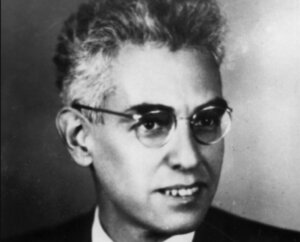Alexander Luria, a Pioneer in Neuropsychology

Strictly speaking, Alexander Luria was probably the first neuropsychologist in history. This branch of knowledge unites psychology with neurology. While it seems an obvious concept today, it was unthinkable less than a century ago.
Lev Vygotsky was Luria’s great inspiration. They met in Moscow when Luria was at the start of his career. Vygotsky had such an influence on him that some say the works of the two men are virtually inseparable.
We consider Alexander Luria the first researcher to fully link the nervous system with behavior. In fact, he greatly contributed to the field of knowledge that had just been born in the 20th century.

The career of Alexander Luria
Alexander Luria was born on July 16, 1902, in Kazan, Russia. His mother, Victorovna Haskin, was a dentist. His father, Roman Albertovich Luriya, was a doctor. They were both Jewish and gave their son a good education. In fact, Alexander spoke several languages and inherited his parent’s love of science.
Luria began school at the age of seven. However, the Russian Revolution interrupted his education. When he was 16, he started training as a doctor at Kazan Federal Unversity. He got his doctorate in psychology from the First Moscow State Medical University in 1921.
In 1922, Luria helped to create the Kazan Psychoanalytic Society. At this time, his readings centered on the work of Freud and Jung. He later began his career as a professor at the Academy of Psychological Sciences of the Soviet Union.
He met Vygotsky at a psychoneurological conference in 1924. Afterward, they both worked at the Clinic of Nervous Diseases of Moscow University. Vygotsky became his mentor. Not long afterward, they began to produce work together.
Neuropsychology
Luria criticized Pavlov’s theories in 1925. For this reason, they removed him from the scientific elite until after Stalin’s death. Luria knew that his views had no place in the dictatorial regime. Therefore, he dedicated himself to studying the brain.
At that time, the medical profession believed in localizationism. This is the theory that different functions can be localized to different areas of the brain. However, Luria thought differently. He proposed the correct idea. Indeed, he confirmed the fact that brain fragments didn’t perform functions. Instead, a complex functional system is involved.
Lurio focused much of his attention on studying language. He was particularly interested in understanding aphasia. This is a language disorder characterized by difficulty or inability to communicate. Luria intended to establish the relationship between this disorder and thought.

Pioneering work
During World War II, they sent Luria to a front-line military hospital in Kisegach. There, he had the opportunity to observe the effects of brain injuries on abilities and behavior. In fact, many of the soldiers had head injuries. For this reason, despite being in the midst of a warzone, he was able to advance his approach.
He developed tests to show the effects of lesions on cognition. From there, he identified cognitive disorders and showed their location in the brain. This meant that neurosurgeons could operate on them. He was also able to explain the effects of injuries on language in depth.
Luria continued to investigate the relationship between language and thought after the war had ended. However, he now chose to focus on children with intellectual disabilities. In 1968, they named him a member of the United States Academy of Science. He died in Moscow in 1977 from a heart attack.
Luria’s findings were reflected in his books. Among others, he wrote Higher Cortical Functions in Man (1962), Human Brain and Psychological Processes (1966), The Working Brain (1973), and The Man with a Shattered World: The History of a Brain Wound (1987). His work has been fundamental to the understanding of the brain and the design of rehabilitation techniques.
All cited sources were thoroughly reviewed by our team to ensure their quality, reliability, currency, and validity. The bibliography of this article was considered reliable and of academic or scientific accuracy.
Maia, L. A. C. R., Silva, C. F. D., Correia, C. R., & Perea-Bartolomé, M. V. (2006). El modelo de Alexander Romanovich Luria (revisitado) y su aplicación a la evaluación neuropsicológica.
This text is provided for informational purposes only and does not replace consultation with a professional. If in doubt, consult your specialist.








